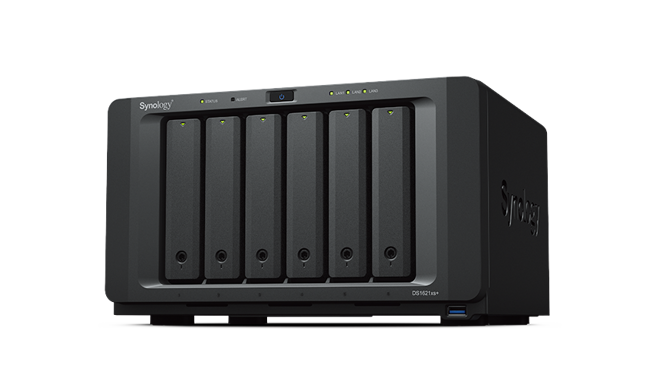Synology announces the DS1621xs+, a high-end network attached storage device
Expand your network storage to up to 96 terabytes with ultra-fast read and write speeds with Synology's new DS1621xs+ network-attached storage device.

The DS1621xs+ was designed to meet the growing need of at-home workers. The small size fits in well in nearly any workspace, and the quad-core Xeon processor, user-upgradeable ECC memory, and onboard 10-gigabit Ethernet paired with two Gigabit Ethernet ports provide high-performance data storage, container solutions like Docker, and file management.
It boasts 3.1Gbps read and 1.8 Gbps write speeds, making it a perfect solution for power users or larger data sets from multiple users. A pair of M.2 slots provide for fast caching.
Beyond the PCI-E x8 slot internal to the device, three USB 3.1 type A ports allow for external expansion.
Nearly all modern networking protocols are supported by the device. Time Machine backups to the unit are possible, and configurable with a web-based interface.
Inside the DS1621xs+ are six internal 3.5-inch bays, which allow for up to 96 terabytes of storage. Should users need more space, it can expand to 256 terabytes of storage by adding on two additional DX517 expansion units for a total of 16 bays.
The DS1621xs+ is available from B&H Photo for $1599.99 with no drives, and is expected to ship within two weeks.
AppleInsider has previously reviewed a Synology NAS -- the DS-1618+ -- and gave it a 4 out of 5, praising its impressive power to price ratio.

The DS1621xs+ was designed to meet the growing need of at-home workers. The small size fits in well in nearly any workspace, and the quad-core Xeon processor, user-upgradeable ECC memory, and onboard 10-gigabit Ethernet paired with two Gigabit Ethernet ports provide high-performance data storage, container solutions like Docker, and file management.
It boasts 3.1Gbps read and 1.8 Gbps write speeds, making it a perfect solution for power users or larger data sets from multiple users. A pair of M.2 slots provide for fast caching.
Beyond the PCI-E x8 slot internal to the device, three USB 3.1 type A ports allow for external expansion.
Nearly all modern networking protocols are supported by the device. Time Machine backups to the unit are possible, and configurable with a web-based interface.
Inside the DS1621xs+ are six internal 3.5-inch bays, which allow for up to 96 terabytes of storage. Should users need more space, it can expand to 256 terabytes of storage by adding on two additional DX517 expansion units for a total of 16 bays.
The DS1621xs+ is available from B&H Photo for $1599.99 with no drives, and is expected to ship within two weeks.
AppleInsider has previously reviewed a Synology NAS -- the DS-1618+ -- and gave it a 4 out of 5, praising its impressive power to price ratio.

Comments
I assume this is not a terribly robust system since Thunderbolt isn't a common networking connection. Not sure how well it would scale up to more than 2 Macs. Can you just continue to daisy chain Macs until you run out of thunderbolt cables & Macs?
I'm happy to see the 10GbE & SSD cache drives move down from the expensive Rackstation line to the more budget-friendly Diskstation line. I would love to use a NAS device for primary project storage, freeing my primary Mac workstation from hosting this storage. It would be easier to access project files using my MacBook Pro when I'm away from my desk, not to mention being able to remote into the Diskstation remotely.
Still looks cool.
The backups finished in about an hour and fifteen minutes and I did not notice any buffering during the Plex playback. The utilization of the 4 bonded interfaces never crossed 60%. The interfaces on the Macbook Pro and Linux server were of course saturated. At least for the moment I do not need to make the choice between the 10Gb or NVMe.
Edit: https://www.amazon.com/Synology-Ethernet-Adapter-E10M20-T1-RJ-45/dp/B089RHK7CF